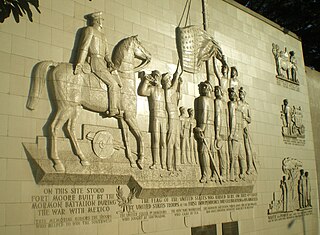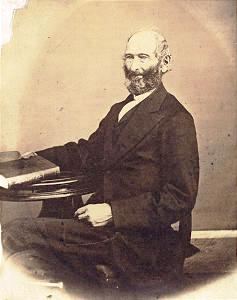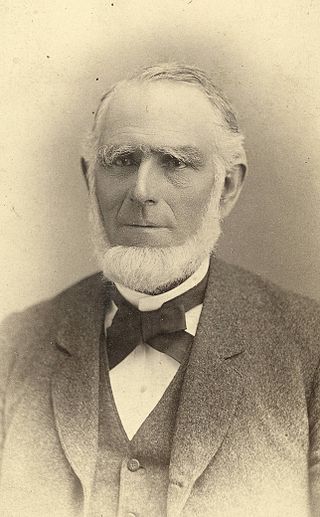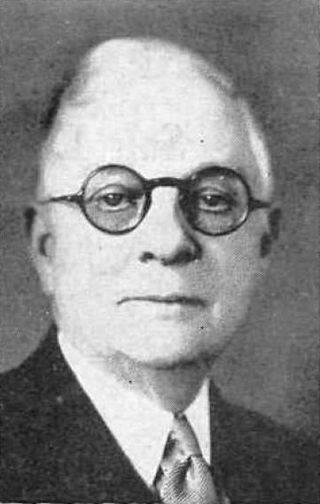
The Mormon Battalion was the only religious unit in United States military history in federal service, recruited solely from one religious body and having a religious title as the unit designation. The volunteers served from July 1846 to July 1847 during the Mexican–American War of 1846–1848. The battalion was a volunteer unit of between 534 and 559 Latter-day Saint men, led by Mormon company officers commanded by regular U.S. Army officers. During its service, the battalion made a grueling march of nearly 2,100 miles from Council Bluffs, Iowa, to San Diego, California.

Richard Roswell Lyman was an American engineer and religious leader who was an apostle in the Church of Jesus Christ of Latter-day Saints from 1918 to 1943.

John Whitmer was an early leader in the Latter Day Saint movement. He was one of the Eight Witnesses of the Book of Mormon's golden plates. Whitmer was also the first official Church Historian and a member of the presidency of the church in Missouri from 1834 to 1838.

William Wines Phelps was an early leader of the Latter Day Saint movement. He printed the first edition of the Book of Commandments that became a standard work of the church and wrote numerous hymns, some of which are included in the current version of the Church of Jesus Christ of Latter-day Saints' hymnal. He was at times both close to and at odds with church leadership. He testified against Joseph Smith, providing evidence that helped persuade authorities to arrest Smith. He was excommunicated three times and rejoined the church each time. He was a ghostwriter for Smith. Phelps was called by Smith to serve as assistant president of the church in Missouri and as a member of the Council of Fifty. After Smith's death, Phelps supported Brigham Young, who was the church's new president.

Edward Partridge Sr. was one of the earliest converts to the Latter Day Saint movement and served as the first Bishop of the Church.

Abraham Owen Smoot was an American pioneer, businessman, religious leader, and politician. He spent his early life in the Southern United States and was one of seven children. After being baptized a member of the Church of Christ, predecessor to the Church of Jesus Christ of Latter-day Saints, Smoot served as a missionary in Kentucky, Tennessee, South Carolina, and England. He received no formal education, but learned to read as a child and later attended the School of the Prophets in Kirtland, Ohio. Like other early members of the LDS Church, Smoot practiced plural marriage, eventually marrying six women and having 24 children. After migrating west to Utah Territory, he was elected as the second mayor of Salt Lake City and maintained this position from 1857 to 1866. He was then assigned by Brigham Young to move to Provo, where he served as stake president and mayor from 1868 to 1881. He assisted financially in the construction of the Provo Tabernacle—today the Provo City Center Temple—as well as that of the Utah Southern Railroad. Smoot was the first president of the board of trustees of Brigham Young Academy (BYA)—which later developed into Brigham Young University (BYU). He was an early financial supporter of the institution and was nicknamed the "foster father" of the academy. His goal was to make education available to young Latter-day Saints. Today, the Smoot Administration Building at BYU is named after him.

The International Society Daughters of Utah Pioneers is a women's organization dedicated to preserving the history of the original settlers of the geographic area covered by the State of Deseret and Utah Territory, including Mormon pioneers. The organization is open to any woman who is: (1) A direct-line descendant or legally adopted direct-line descendant with a pioneer ancestor; (2) the pioneer ancestor is a person who traveled to or through the geographic area covered by the State of Deseret/Utah Territory between July 1847 and 10 May 1869 ; (3) over the age of eighteen, and of good character. Travel through the geographic area covered by the State of Deseret/Utah Territory can be either east to west, west to east, north to south, or south to north.

Jane Elizabeth Manning James, fondly known as "Aunt Jane", was an early African-American member of The Church of Jesus Christ of Latter-day Saints and traveled to Utah as a pioneer. She lived with Joseph Smith and his family for a time in Nauvoo, Illinois. She traveled with her family to Utah, spending the winter of 1846–1847 at Winter Quarters, and was among the first of the pioneers to enter the Salt Lake Valley in 1847. As a black woman, James was not allowed to enter the temple during her lifetime and petitioned the First Presidency of the church multiple times to be endowed and sealed. As a result of her requests she was adopted as a servant into the family of Joseph Smith through a specially-created temple ceremony. She was posthumously endowed by proxy in the Salt Lake Temple in 1979.
Thomas Glen Alexander is an American historian and academic who is a professor emeritus at Brigham Young University (BYU) in Provo, Utah, where he was also Lemuel Hardison Redd, Jr. Professor of Western History and director of the Charles Redd Center for Western Studies. After studying at Weber State University (WSU) and Utah State University (USU), he received a PhD from the University of California, Berkeley in 1965. He taught history at BYU from 1964 until 2004, and served in the leadership of various local and historical organizations.

Andrew Jenson, born Anders Jensen, was a Danish immigrant to the United States who acted as an Assistant Church Historian of the Church of Jesus Christ of Latter-day Saints for much of the early-20th century. Jenson also served the church as president of the Scandinavian Mission.

Thomas Bullock was a Mormon pioneer and a clerk in the Church Historian's Office of the Church of Jesus Christ of Latter-day Saints.

Phineas Howe Young was a prominent early convert in the Latter Day Saint movement and was later a Mormon pioneer and a missionary for the Church of Jesus Christ of Latter-day Saints. Phineas Young was an older brother of Brigham Young, who was the president of the LDS Church and the first governor of the Territory of Utah.

Levi Edgar Young was a general authority of the Church of Jesus Christ of Latter-day Saints. He was one of the seven presidents of the Seventy from 1909 until his death. He has been associated with the release of the 1832 account of Joseph Smith's First Vision, which was previously not widely known. Aside from his service in the Seventy, Young served as president of various LDS Church missions. Young received a master's degree from Columbia University in history and was a professor of history at the University of Utah.

Eugene Edward "Gene" Campbell was an American professor of history at Brigham Young University.

Francis Washington Kirkham was a prominent educator and the author of New Witness For Christ in America: Evidence of Divine Power in the "Coming Forth" of the Book of Mormon, one of the earliest book-length defenses of the authenticity of the Book of Mormon.

Priddy Meeks was an American frontier doctor who practiced Thomsonian medicine. He was a polygamist member of the Church of Jesus Christ of Latter-day Saints and helped settle areas in Utah as a Mormon pioneer. Meeks was the first doctor in Southern Utah. He occasionally appears as a character in Mormon literature, such as the short story "They Did Go Forth" by Maurine Whipple.

Brigham Young was an American leader in the Latter Day Saint movement and a settler of the Western United States. He was the President of the Church of Jesus Christ of Latter-day Saints from 1847 until his death in 1877. He founded Salt Lake City and he served as the first governor of the Utah Territory. Young also led the foundings of the precursors to the University of Utah and Brigham Young University.
Amanda Barnes Smith was an American Mormon pioneer. She survived the Haun's Mill massacre of 1838 in Missouri. She also helped organize the first Relief Society in Salt Lake City.
Mary Alice Powell Lindsay became the first registered nurse in Utah, United States. She studied at the LDS College, the Relief Society Home Nursing program, the Hospital Nurses Training School in Battle Creek, Michigan, and the University of Utah. She was a member of the Church of Jesus Christ of Latter-day Saints, participated in the Young Women Mutual Improvement Association (YWMIA), and volunteered for the Boy Scouts of America. She also helped organize a maternity hospital and health conferences in the state of Utah. She was an active member of the local Relief Society in the LDS Church.
Heber Robert McBride was an autobiographer who immigrated to the United States from England in 1856 at the age of thirteen. He was a Mormon pioneer who migrated to Utah with the Martin Handcart Company. McBride was a member of the Church of Jesus Christ of Latter-day Saints.













